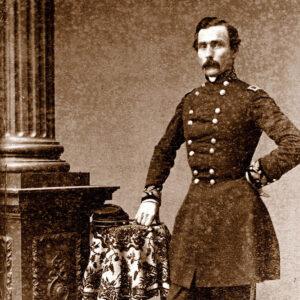calsfoundation@cals.org
Fort Pleasants
aka: Fort Weightman
Fort Pleasants was a large Confederate fortification erected on Day’s Bluff near Pine Bluff (Jefferson County) on the Arkansas River in order to impede any attempts by Union forces to advance on Little Rock (Pulaski County) using the river in 1863.
Following the Union destruction of Fort Hindman during the Battle of Arkansas Post in January 1863, Confederate leaders rushed to fortify high ground upriver from the post to defend the approaches to Little Rock. Missouri troops under Brigadier General Daniel M. Frost were dispatched to White Bluff, located about sixty-five miles below the capital, in early February to begin fortifying there, but on February 18, Frost recommended building an earthwork at Day’s Bluff, fifteen miles farther downstream, writing that with heavy guns “a force of 10,000 ought to stop 30,000 at that point.”
The Confederates impressed 150 enslaved people from surrounding plantations to construct the bastion, which was named Fort Weightman in honor of Colonel Richard H. Weightman of the Missouri State Guard, who was mortally wounded at the Battle of Wilson’s Creek, Missouri, in 1861. Lieutenant General Theophilus Holmes ordered the name changed to Fort Pleasants in March 1863, recognizing Colonel J. C. Pleasants of the Twenty-Ninth Arkansas Infantry Regiment, who was killed in the Battle of Prairie Grove.
While the landward side of Fort Pleasants was earthen, it was reported that the areas most likely to face Federal fire had “heavy earthworks palisades with cypress timbers, calculated to resist heavy artillery. In the north west [sic] corner of the fort, there is being thrown up heavy embankments for siege artillery on the most commanding ground from which position heavy artillery can command the river for one thousand yards.” Confederate engineer Henry Merrell, however, contended that Fort Pleasants was built “at a place so much out of the way as to suggest the inference that it may have been built more to interest the men & keep them employed than for any use against the enemy.”
Confederate troops continued to man Fort Pleasants through the summer of 1863 until the advance of Union cavalry from southeastern Missouri via Crowley’s Ridge and infantry from Helena (Phillips County) revealed that the campaign to capture Little Rock would come from eastern Arkansas rather than the Arkansas River, and the fort was abandoned.
Some of the earthworks from Fort Pleasants still survive in an extremely deteriorated condition, but much of the formerly formidable fortification was destroyed during construction of the Pine Bluff Arsenal.
For additional information:
Banasik, Michael E., ed. Serving with Honor: The Diary of Ethan Allen Pinnell of the Eighth Missouri Infantry (Confederate). Iowa City, IA: Press of the Camp Pope Bookshop, 1999.
Christ, Mark K. Civil War Arkansas, 1863: The Battle for a State. Norman: University of Oklahoma Press, 2010.
Powell, Richard Stephen. “Fort Pleasants, Arkansas, CSA February 20–July 27, 1863.” Jefferson County Historical Quarterly 49 (Summer 2021): 18–22.
———. “Searching for Fort Pleasants.” Jefferson County Historical Quarterly 49 (Summer 2021): 24–27.
Skinner, James L., III, ed. The Autobiography of Henry Merrell, Industrial Missionary to the South. Athens: University of Georgia Press, 1991.
Mark K. Christ
Central Arkansas Library System
 Civil War through Reconstruction, 1861 through 1874
Civil War through Reconstruction, 1861 through 1874 Military
Military Daniel Marsh Frost
Daniel Marsh Frost 




Comments
No comments on this entry yet.